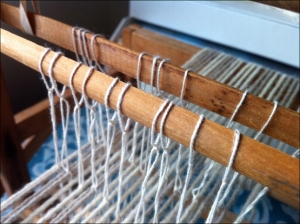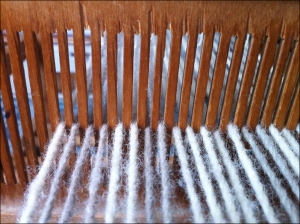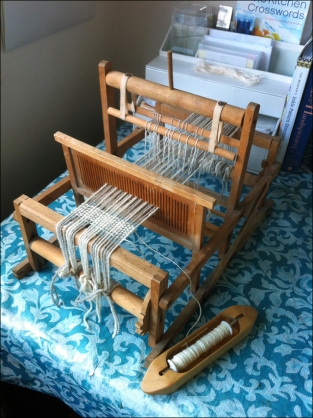You may think I’m kidding, but the fiber arts can lead you down a perilous road. Mostly due to the interesting diversions along the wayside.

My friend chopsticknitter has already posted a batch of pictures from the Twist festival in her blog, so I’ll be brief in my review: it was lots of fun, and it has indirectly provided me with more potential blogging content than I know what to do with. In terms of fiber, I stocked up on Shetland, Cheviot, alpaca, and even a bit of bison. (For the sake of my dignity, this indecent haul will not be pictured.) My favorite, though, is the tiny sample of qiviut that is now occupying my supported spindle. This is shockingly beautiful stuff.

Of course, I have to mention our trip to the loom room. After the greedier other members of my group appropriated the most exotic looms, I found my way to a Fanny just like my own, but pre-warped and conveniently unattended.

We also passed a room that had clearly been occupied by a dyeing workshop, which would have been fun to take. I’ve always been fascinated by natural dyeing. After getting back from the festival, and having picked up all that springy Cheviot, I wound off a batch of ten-yard skeinlets for my schemlets.*

To date, I’ve experimented with lac, madder, cutch, logwood, pomegranate, turmeric, chamomile, and some rather unsightly black beans. Aside from the lac, these are all plant dyes. (Lac dye comes from a bug-produced resin, making it less icky than dyeing with cochineal, which involves grinding up bugs. I might not mind, but my significant other is concerned that we might find dried insects scattered around the kitchen. He’s probably right.) Anyway, I think the sample skeins will be perfect for weaving a color gamp or two.
“But, tintinnael,” you may ask, “how will you weave any gamps? Isn’t your loom already occupied?”
Well, yes, it is:

But on Saturday, my mother happened to come across this dainty creature gathering dust in the corner of a weaving shop in Vermont. As soon as I saw it, it was love.
It’s a two-shaft counterbalance table loom, toy-sized but fully functional. I’ve seen similar looms on Etsy and eBay, but usually in worse condition for higher prices. (Worthy of note: this one was twenty bucks.) It came intact with a wooden reed and two functioning ratchet-and-pawl mechanisms on the front and back beams. The only things missing: heddles and heddle bars, i.e., string and sticks. So I spend an hour tying string heddles and hacked some dowels to size. To stabilize my makeshift shafts, I tied the lower bars to one another, going underneath the roller at the center of the loom. I’m not sure if this is the originally intended configuration, but it seems to work just fine. And to change the shed, all you have to do is flip the lever on the top of the loom.
Here are some close-up shots of the riggings:
Although it looks delicate, I am pleased to report that the little loom holds up to a good amount of tension. I wouldn’t use it to make floor rugs, but tiny tapestry samples are not out of the question. (Also, I’m careful to take the tension off the warp after every weaving session, a suggestion I read somewhere and have internalized to the point of neurosis. Fellow weavers, is this good practice?)
So, my next project seems likely to be a natural-dye gamp on this little charmer. See how one thing leads to another? There’s no hope for any of us fiber folk.
If you’ve made it this far into my rambling post, you may be interested to see my brand-new Twitter page, also linked from the sidebar to your right. I’m starting to get into the tweeting habit: if you’re there, let me know!
—
*I know. It doesn’t rhyme.








I’ve got my eyes on those lovely shades of pinks, purples and blues! Gorgeous color!
Question from a non-weaver (so forgive me if it’s dumb!), what is the difference between that adorable little loom and a rigid heddle? You referred tothis one as a two shaft, but wouldn’t that be the equivalent of a rigid heddle?
LikeLike
I just managed a mauvey shade that you might like! Still feel like doing some knitting?
In terms of what you can weave, it’s the equivalent (more or less). What’s different is the way it’s built: a rigid heddle doesn’t have shafts or harnesses, so you wouldn’t need the dowel-and-string contraptions you see above. The rigid heddle is more like a movable reed with holes as well as slots. You could make one fairly easily if you were so inclined!
LikeLike
What a clever person you are…to bring that petit loom back to life! So glad it has a forever home.
LikeLike
My little brio loom came to me as an early Christmas gift from my dear hubby John.
I have just started weaving on it . It is actually my second loom . I however have had to sell my first which was not a very good one, In any case,this little loom is a lot of fun to work on. Mine is a newer model with a red plastic rigid Heddle and plastic(nylon?) rachet and pawl set up. I to have taken to releasing tension on the warp before leaving my project each time I’m not at all sure if this is common practice either but it seems logical to me.
LikeLike